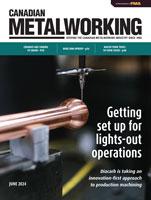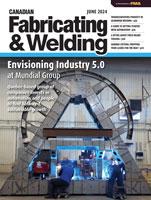Editor
- FMA
- The Fabricator
- FABTECH
- Canadian Metalworking
The punch/laser combo: When it makes sense for your shop
Each individual technology has its value, but together is better for some shops
- By Rob Colman
- May 22, 2024
- Article
- Fabricating
Since the introduction of laser cutting, the appeal of punch presses has become more of a niche proposition. The punch press is still the best bet if you are doing operations such as tapping or multiple forms such as louvres, but the speed of a fibre laser wins out in many other situations.
There is, of course, a middle ground for the right applications: punch/laser combo machines. The question is, when can this approach trump the either/or option?
Options Open
“A lot of people have moved to using laser cutting because they think that it is faster, and for certain applications it certainly is,” said Thomas Weir, punching product sales manager, LVD North America. “A laser is also quieter than a punch. But people forget that punches have forming capabilities that lasers don’t have.”
The punch press, on the other hand, is a cost-effective machine for the right shop.
“Many shops that have always used punch technology understand it, and it fits their needs,” said Kyle Plass, regional sales manager, Prima Power. “Given their product mix, sometimes it is the most cost-effective method.”
“The initial outlay for the machine is relatively less expensive, and even with having to buy tooling, tooling is not particularly expensive,” said Weir. “And of course, you don’t have the consumables and gases to worry about. And in the right applications, especially for a hole-intensive part, it can be a lot faster. Our fastest punching machine will do more than 500 hits per minute. That’s much faster than cutting the entire circumference of all those holes on a laser.”
But many parts require both technologies.
“A laser/punch combination machine can equate to a Swiss Army Knife,” said Plass.
Weir agreed.
“A customer may have louvres, tapping, electrical knockouts or embossing—things that a laser can’t do. But that same job may require an edge quality that nibbling can’t achieve,” said Weir. “That’s just one example of how a combo machine can help a shop.”

A laser/punch combination machine is the Swiss Army Knife of metal fabricating. It offers the forming and part marking capabilities of a punch and the intricate internal and external contouring capabilities of a laser. Prima Power
Beyond just the forming capabilities of a punch, a shop may need detailed part marking capabilities (for instance, a QR code) for downstream processes—capabilities that may not be available on a laser—while also needing the laser for intricate internal and external contouring.
Prima is known for its punch/shear combo machines, which Plass said are used by many companies to create large enclosures or box-like structures such as door panels and other rectangular forms.
“The punch/shear is an obvious choice for shops making those types of structures,” said Plass. “But if a shop has to process thicker materials, generally a thickness greater than 12 ga.; more advanced external contours; or smaller components that suit mixed production orders and can be sorted at the machine; the laser punch combo makes more sense.”
Combined Flexibility
Punching is generally ideal when working on sheet that is a maximum of 12 or 10 ga., according to Weir.
“After that, the amount of time spent sharpening tools due to more aggressive hits means that your ROI diminishes,” Weir explained. “At that point, you are better off using a laser. All of our tools are rated to punch ¼-in. steel, but it isn’t the most effective way to do that job.”
A combo machine shifts this analysis at least a little, however.
“If you can eliminate a secondary operation on material that is a little thicker, it can work,” said Weir. “Tapping into ¼-in. steel would likely be too aggressive, but a countersink tool or a forming tool that would save you from having to use a milling machine might make sense.”
With the laser removing the need to contour shapes with the punch, there is less punch maintenance necessary.
A combination machine may just open new markets to a punch-heavy job shop as well.
“With the cost of shop space, if a company is doing 80 per cent punch work but can gain market share by having that laser capability, it can make a lot of sense,” said Plass. “It may be an ideal replacement for a currently outdated process in a shop, such as a CO2 laser or CO2/punch machine.”

Punch presses offer efficient part sorting, a capability that poses a challenge for most flat sheet laser machines. It is commonplace for punches and punch/laser combos to pick parts using suction tables and drop bins. LVD punch/laser combination machines have a drop door that’s 16 by 60 in. wide. LVD Group
Laser Limitations
Of course, it’s impossible to capture every single capability of each individual technology in one package. Something has to give. Mainly, that give takes place in laser speed and, on some machines, cutting breadth. In terms of laser speed, this is because, in some cases, the table moves in the X and Y axis and the laser is stationary. In other cases, the laser only moves in the Y axis.
“It’s obviously not a flying-optic that you’re using on a combination machine,” said Weir. “Even though our laser head does move on the Y axis, the sheet still moves on the X axis, so you’ll never get close to the speed of a flying-optic because of that requirement. But you make up for that in process combinations where you can eliminate secondary processes.”
Limitations of the punch/laser combo machine can include the size of the cutting table and sheet utilization – the amount of material that can be cut by the laser.
“On some machines, you may be able to punch a full 5- by 10-ft. sheet, but the laser may be limited to 5 by 8 ft. because the laser head might be offset from the die centre,” said Weir. This may not be an issue, depending on the job, but it’s important to understand that such limitations exist.
Punch Press Benefits
Generally speaking, the punching side has no similar downsides.
“We still allow the same turret layout and the same tonnage required on the specs of a stand-alone machine,” said Weir.
“You also gain from being able to do multiple hits on a sheet at once,” said Plass. “For instance, if you use a cluster tool, combining multiple punches in one hit, you might achieve multiple hits in less than a second. So if you’re doing a grid pattern or a perforated sheet, it is much faster to punch it out.”
Another benefit of using a combo machine is that some of a stand-alone punch’s cutting tools can be eliminated, meaning that more specialized tooling like multitools can stay on the turret.
“This means fewer tool changes for special applications—time savings that may be relatively small but that add up during the lifecycle of the machine,” said Plass. “In our case, we can design the turret to customer needs, meaning that in many cases, this offers the possibility of zero setup for tool changes.”
Part Sorting
One aspect of punch presses that remains a struggle for most flat sheet laser machines is efficient part sorting. Part picking with the use of suction tables and drop bins, meanwhile, is commonplace with punches and punch/laser combos.

Limitations of the punch/laser combo machine can include the size of the cutting table and sheet utilization – the amount of material that can be cut by the laser. Prima Power’s combination punch/laser can achieve 100 per cent sheet utilization with its automated clamping system, despite the fixed laser cutting head. Prima Power
“On our machines, we have a drop door that’s 16 by 60 in. wide,” said Weir. “For larger parts or stainless parts that you want to assure aren’t scratched in the process, we have a vacuum bridge that picks the parts and stacks them. Being able to do that and dispose of the skeleton efficiently can be a game-changer for a shop.”
This combined with efficient sheet changing, can save shops significant amounts of time.
“Sheet change time is an issue that many people don’t consider when looking at a new machine, but the time difference between different laser combination machines can be as much as 60 seconds per sheet change,” said Plass. “This time adds up through the week and in some cases can equate to one additional shift of production per week.”
Plass quoted a colleague who always said, “horses for courses” when it came to shopping for sheet processing equipment.
“There’s a correct machine for every job,” he said. “By clearly understanding your shop needs, you can determine which has the correct balance of capabilities for your customer base.”
Editor Robert Colman can be reached at rcolman@fmamfg.org.
LVD Group, www.lvdgroup.com
Prima Power, www.primapower.com
About the Author

Rob Colman
1154 Warden Avenue
Toronto, M1R 0A1 Canada
905-235-0471
Robert Colman has worked as a writer and editor for more than 25 years, covering the needs of a variety of trades. He has been dedicated to the metalworking industry for the past 13 years, serving as editor for Metalworking Production & Purchasing (MP&P) and, since January 2016, the editor of Canadian Fabricating & Welding. He graduated with a B.A. degree from McGill University and a Master’s degree from UBC.
Related Companies
subscribe now


Keep up to date with the latest news, events, and technology for all things metal from our pair of monthly magazines written specifically for Canadian manufacturers!
Start Your Free Subscription- Trending Articles
Small-footprint waterjet brings fast, general-purpose cutting to any shop

Welding 101: A Supervisor’s Guide

Fabrication management features added to job shop software

Cartridge system protects materials during shipping, handling

Compact air-powered unit punches sheet, angle, and tubing

- Industry Events
MMTS 2024
- June 18 - 20, 2024
- Montreal, QC Canada
RAPID + TCT
- June 25 - 27, 2024
- Los Angeles, CA
IMTS 2024
- September 9 - 14, 2024
- Chicago, IL
WiM Summit 2024
- October 6 - 9, 2024
- Boston, MA
FABTECH 2024 Orlando
- October 15 - 17, 2024
- Orlando, FL
















